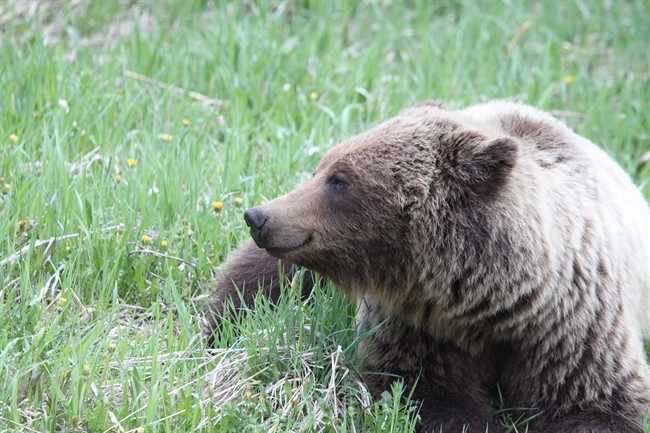Newly published research suggests conflict between humans and grizzlies in the mountains and foothills of southwestern Alberta has been growing for more than a decade.

“We started to see substantial increase in the incidents starting in about 2006,” said Andrea Morehouse, a scientist at the University of Alberta.
“Not only are we seeing these incidents increase in number and frequency, we’re also seeing them occur on increasingly eastern areas of the landscape.”
Morehouse and her colleagues went through more than 6,300 provincial government documents that recorded human contact with grizzlies, black bears, wolves and cougars from 1999 to 2014. That contact ranged from a distant sighting to a dangerous or destructive encounter.
They found little change in the contact with black bears, wolves and cougars.
But grizzlies recorded a dramatic increase. The number of contacts went from fewer than 50 to about 200 – a fourfold increase.
READ MORE: Bear 148 moved 500 km north of Canmore after week of ‘daily’ human encounters
Watch below: On May 15, 2017 naturalist Kevin Van Tighem, a former superintendent at Banff National Park, joined Global Calgary to discuss why Bear 148 seems to have no fear of humans.

Yet land use in the area has been consistent and the human population is stable or decreasing.

Get daily National news
“We eliminate human population increase and changes in demographics as the main reasons behind increasing carnivore conflicts,” the report says.
One reason for the growth could be the elimination of the spring grizzly hunt in 2006. After that date, farmers and ranchers could no longer simply kill a grizzly they believed was harming their operations.
Producers may now be calling in about bears they would have previously dealt with on their own, suggested Morehouse. As well, people who aren’t used to seeing bears may also be more likely to report them.
“We might expect those people are going to call more frequently as opposed to people who are used to living with bears.”
Or there may simply be more bears. Morehouse has previously published research that suggested grizzly populations in the area were increasing at about three per cent a year.
The latest study found grain bins – full of tasty carbohydrates – are a major site for bear-human encounters.
“Bears can peel off the doors on those grain bins,” Morehouse said. “It’s like they’re opening a sardine can.”
Some farmers have installed electric fencing around their bins or put bear-proof doors on them. Bear-proof bins are also available for dead animals that might otherwise attract predators.
Producers can also get reimbursed for the cost of a visit from a rendering truck to deal with carcasses.
Morehouse found that one government program definitely didn’t work. The province used to airlift roadkill carcasses to bear dens in the spring hoping that would keep the hungry bruins in the high country.
Morehouse concluded there was no evidence it did so.
However, most people in the region are keen to keep living with large predators, said Morehouse.
“One of the really exciting things about southwest Alberta is that there is an extremely proactive group of people down here that are working on these issues.”
They may already be making a difference. Early data from 2015-16 suggests grizzly-human encounters in the area may be down for the first time this century.
“Maybe we’re starting to have a bit of an impact.”


Comments